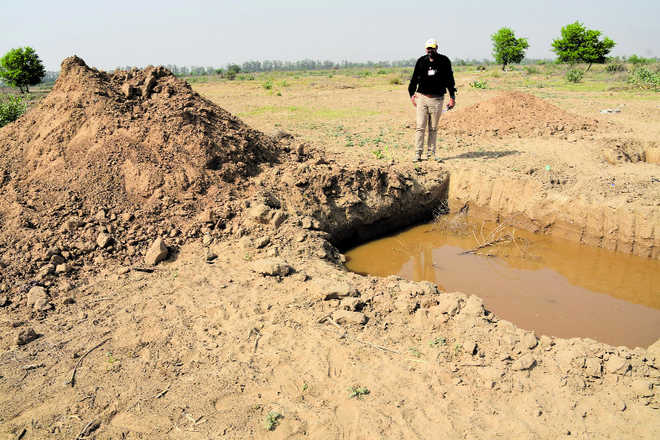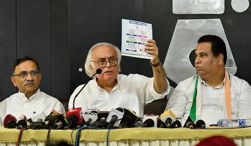
GREEN GONE BARREN: An NPCIL official at the nuclear plant site at Gorakhpur (Fatehabad)
Deepender Deswal in Gorakhpur (Fatehabad)
As you head for Gorakhpur from Hisar, a mere 40km drive, you can hardly sense the importance of being there, until you touch the village: a vast stretch of once fertile belt looks desolate as wild vegetation and cacti give a lie to what could be within. Four seasons, four crops richly served by the Bhakra mainline branch — that was the wealth of the villagers, not long ago. Today, a 12-ft wall and barbed wires surround it: the area marks a new high point in policy planners’ scheme of national security. An impressive iron gate with an encrusted Nuclear Power Corporation of India Limited (NPCIL) insignia lets you in if you have the permission. The village has lost its 1,503 acres for NPCIL to build a 2,800 MW — 700x2 MW in first phase — nuclear plant.
But, where is the plant? The answer may lie as much inside the compound as outside — 33 years after the district administration recommended Gorakhpur as a fit place for the mega project. The place is said to be located in a low seismic zone, and where people can be persuaded to part with their land in exchange for hefty monetary compensation: Rs 537 crore so far to 481 landowners. That has been but one story since 1984.
Various episodes, however, have happened: all political parties, the ruling BJP included, opposed it, sat on long dharnas with local protesting residents. Many of them, especially the BJP, then, backtracked, after coming to power in 2014. “Now that the farmers have already accepted compensation, there is no point in opposing the project,” says Subhash Barala, state BJP chief who represents Tohana Assembly segment of Fatehabad district.
The Wildlife Institute of India, Dehradun, which was to prepare a conservation plan for blackbucks, had told NPCIL to vacate the land acquired by it for its residential colony. The National Green Tribunal, too, was involved as Akhil Bhartiya Jeev Raksha Bishnoi Sabha, wanted green clearance withdrawn to NPCIL.
Then also came in the fiercely debated 2010 Nuclear Liability Act — one of the last steps needed to activate the 2008 Indo-US civilian nuclear agreement. The US N-reactor manufacturing companies require the liability bill to get insurance in their home state. India is now a member of the international convention on liability in civil nuclear arena. For Gorakhpur, things started moving. On May 27, 2015, the police evicted farmers living on a piece of land acquired by NPCIL. In 2012, NPCIL acquired over 1,503 acres in Gorakhpur, Kajal Heri and Badopal.
The pre-project stage
Former Prime Minister Manmohan Singh laid the foundation stone for the project on Jan 13, 2014. The work on the reactor is yet to start, NPCIL officials say. Only pre-project works are underway. That means building two water storage tanks with a capacity of 45.5 million liters, a few approach roads, a meteorology lab and prefab offices. The project is unlikely to be commissioned for at least the next six years as a host of teething problems persist. The first is the ‘loose’ sub-surface soil. A rocky soil is more suitable for the foundation of such reactors. The project director Gorakhpur Haryana Anu Vidyut Pariyojana (GHAVP), RK Khera, says an agency is investigating the soil properties. “But the issue will be sorted out as the soil can be treated accordingly,” he said. A tender of Rs 150 crore for site excavation would be floated soon to start the digging work for soil treatment.
Six years from now…
He says the actual work would be “deemed as started” from the day of first pouring of concrete (FPC) to construct the reactor building. “Our deadline to commission the project in five years would start from the day of FPC,” says Khera. “We hope to start the work by next year for its commissioning by 2023.”
Khera says the project is linked to the Kakarpar Atomic Power Station (KAPS), near Surat, in Gujarat. “This reactor is in the final stage. The reactor design meant for KAPS is to be replicated at Gorakhpur. Once the design is technically tested at KAPS, the construction can start at Gorakhpur.” The KAPS, Khera said, was high on NPCIL priority and so is the Haryana project. The first phase will generate half of the proposed power, 1400 MWe (700x2).
Cost escalates
The indigenous project covers land in Gorakhpur and its adjoining Kajla Heri and Badopal villages. The Centre has sanctioned a grant of Rs 20,594 crore for the first phase. Delays have resulted in drastic cost escalation. The project, conceived in 1984, was revived in 2009. Project’s HR manager Hoshiar Singh says some crucial pre-project activities have been completed. “Seismic studies, environment and social impact assessments are complete. Some matters relating to environment and wildlife are still pending in a Kurukshetra court. Officials said the government was losing Rs 7-8 crore per day for the delay.
In 33 years…
- 1984: Site survey conducted for the first time
- 2009: Haryana promises land & water
- 2010: Land acquisition starts
- 2012: NPCIL officials arrive for pre-project work
- 2014: PM Manmohan Singh lays foundation stone
- 2015: Atomic Energy Regulatory Board grants consent
- 2018: First four of concrete expected for the first phase
- 2023: Proposed commissioning of the project
The project
- GHAVP would be a 2,800 (700x4) MWe pressurized heavy-water reactor (PHWR)
- PHWR commonly uses un-enriched natural uranium as fuel that uses heavy water as coolant and neutron moderator
- Commissioning in two phases each having four units
- Haryana to get 50% of power. The rest to be auctioned to other states/UTs
Why delay
- The sub-soil is loose with water table at 3-4 meters at the site
- Soil needs treatment for a strong base of reactor buildings
- NPCIL to float Rs 150-crore tender for excavation to prepare the base


























